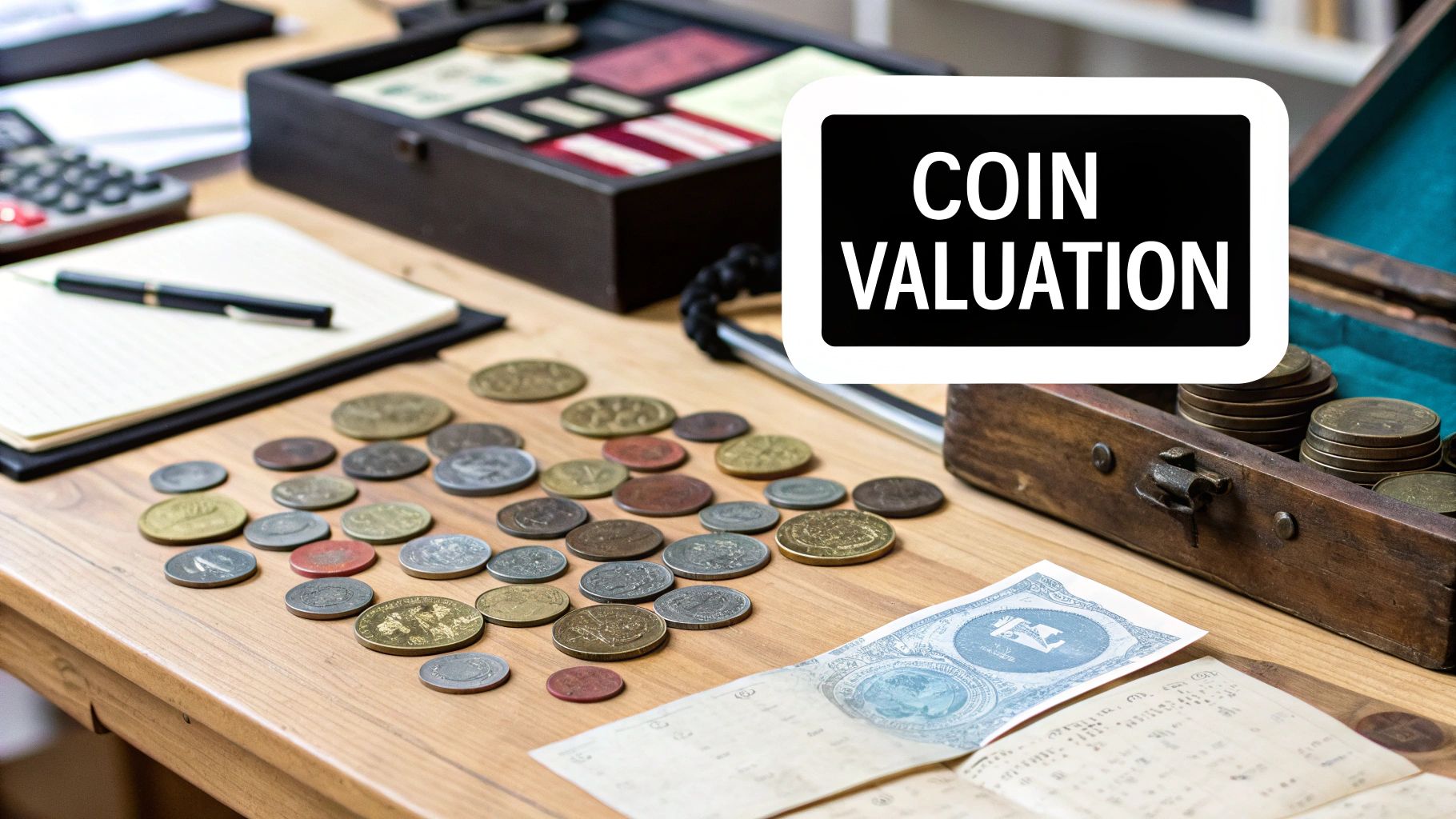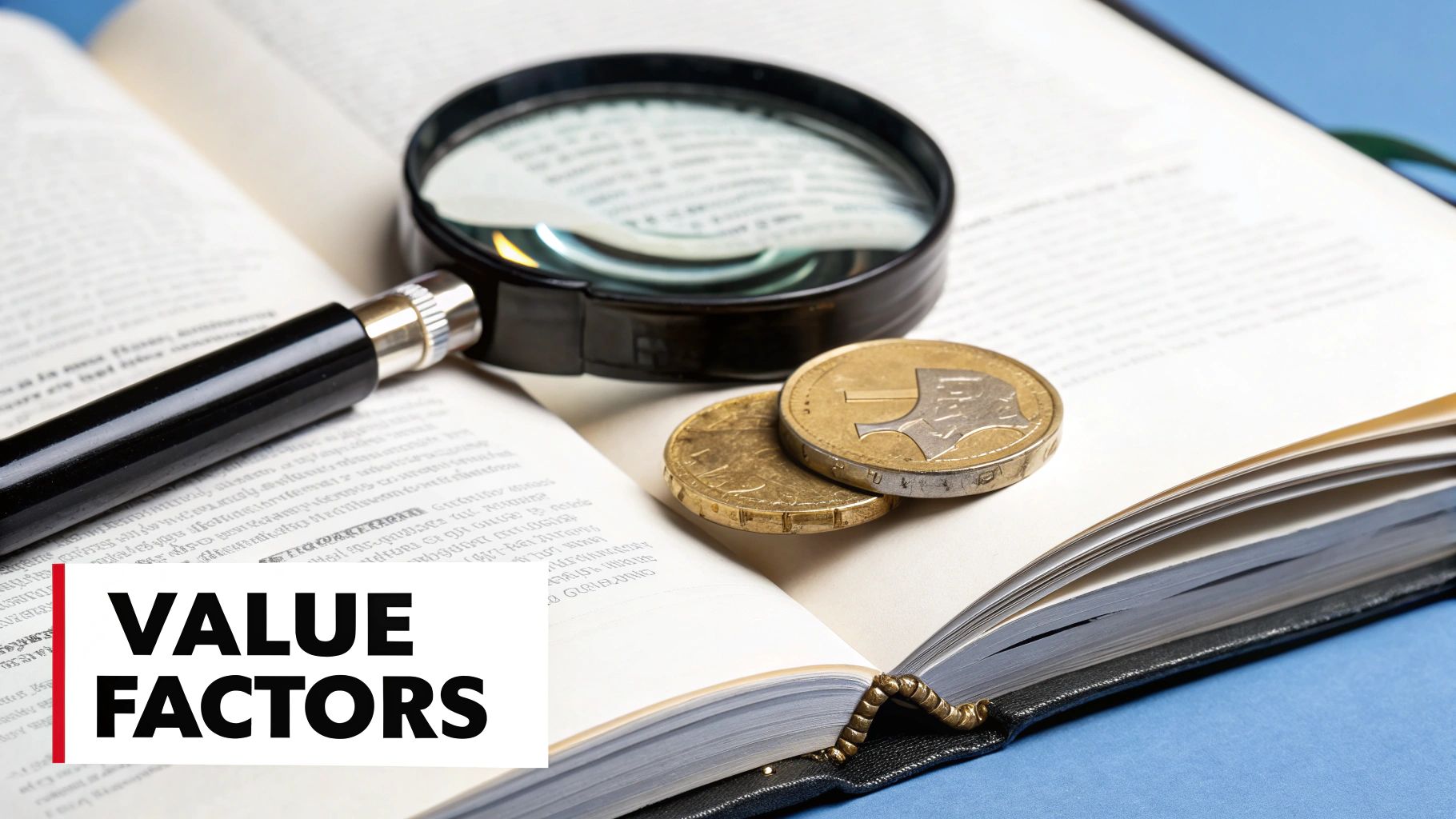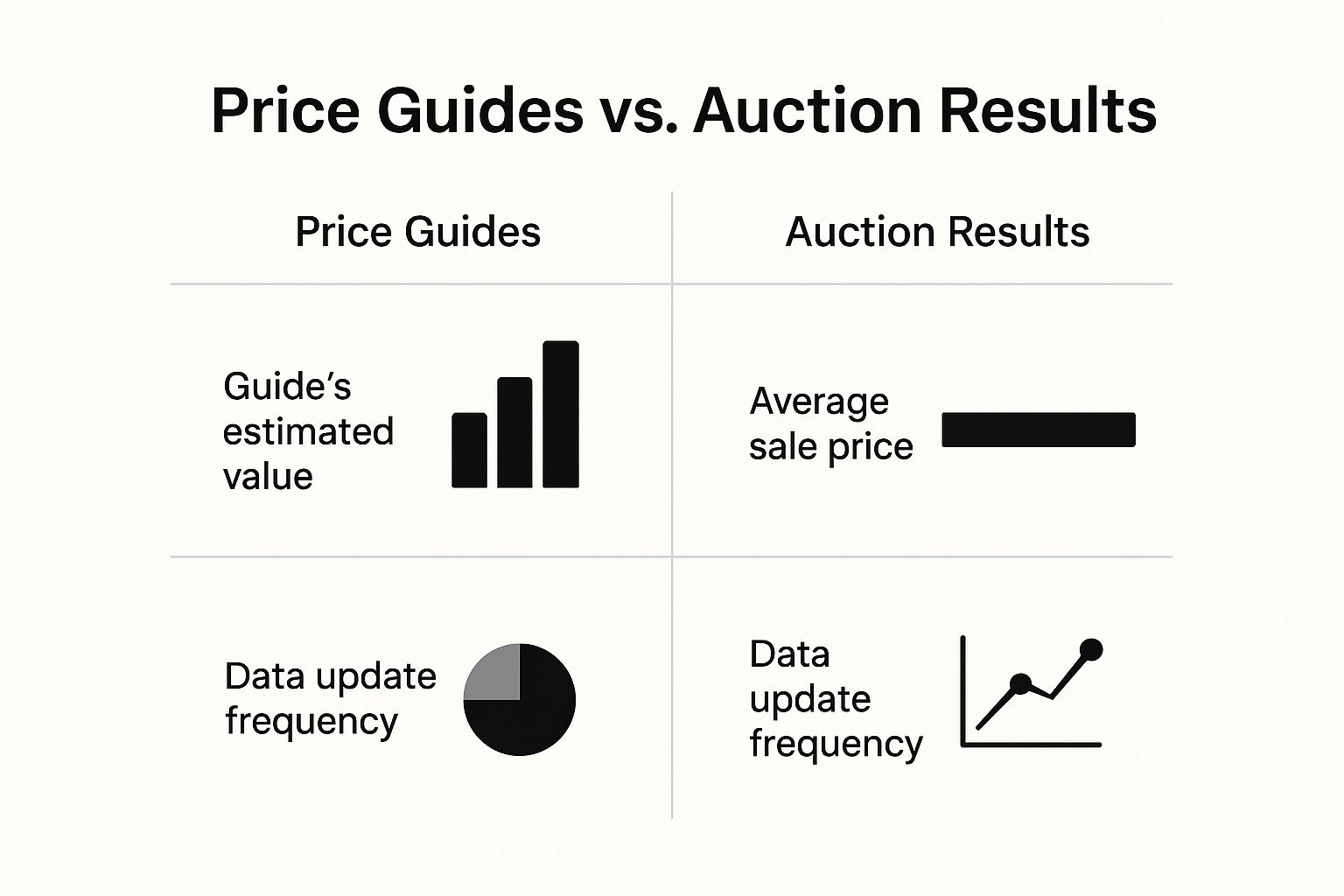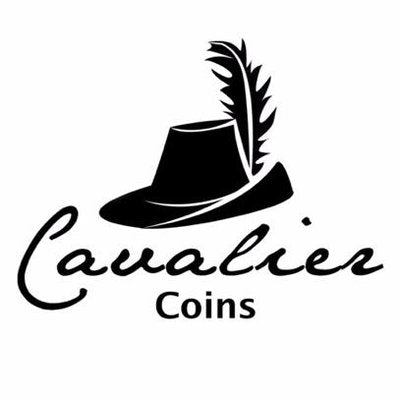So, you're wondering, "how much are my coins worth?" The short answer is that a coin's value really boils down to three things: its rarity, its condition, and what collectors are looking for right now. Some coins are simply worth their face value, but others can be genuine treasures.
Your First Look at Coin Valuation

When you first pick up a coin, you’re holding something with several potential layers of value. Getting a handle on these different layers is the first step towards a realistic idea of what your collection might be worth. It’s a journey that can be incredibly exciting and rewarding.
This initial look isn't about slapping a definitive price tag on everything just yet. Think of it more as organising your thoughts and your coins into a simple framework. This makes the whole valuation process much more manageable. You'll soon learn to see beyond the number stamped on the metal and spot the tell-tale signs of a piece that deserves a closer look.
The Three Types of Coin Value
Every single coin you own has at least one, and sometimes all three, of these values. Keeping them separate in your mind is absolutely crucial for setting realistic expectations from the get-go.
- Face Value: This one's easy. It's the monetary worth stamped right there on the coin, like '50p' or 'One Pound'. For the vast majority of coins currently in circulation, this is as far as their value goes.
- Metal Value: You might hear this called 'melt value' or 'bullion value'. It's simply the worth of the precious metal the coin is made from. A pre-1947 British silver shilling, for instance, is worth far more for its silver content than its one-shilling face value.
- Numismatic Value: This is the collector's value. It's what another person is willing to pay for that specific coin based on its rarity, condition, historical significance, or even interesting errors. This is where a seemingly ordinary 50p can suddenly be worth hundreds of pounds.
Key Takeaway: A coin's true worth is always the highest of its face, metal, or numismatic value. A gold sovereign's value isn't its one-pound face value, but its much higher combined metal and numismatic worth.
Key Factors Determining Your Coin's Value
This table breaks down the main elements that give a coin its value. Use it as a quick reference when you're sorting through your collection to understand what makes one coin stand out from another.
| Valuation Factor | What It Means | Why It Matters |
|---|---|---|
| Rarity | How many of the coin were originally made (mintage) and how many are still around. | Low mintage or few surviving examples create scarcity, driving up demand and price among collectors. |
| Condition (Grade) | The physical state of the coin, from heavily worn to perfectly preserved (uncirculated). | A coin in pristine condition is always more desirable and valuable than the same coin with scratches, wear, or damage. |
| Collector Demand | The current popularity of a specific coin, series, or theme in the market. | High demand for a particular coin can push its price well beyond its basic metal or face value, even for common dates. |
| Metal Content | Whether the coin is made from a precious metal like gold, silver, or platinum. | The intrinsic value of the metal provides a baseline price floor, especially for common-date bullion coins. |
| Provenance | The coin's history of ownership, especially if it belonged to a famous collector or collection. | A documented and interesting history can add a unique story and significant value to a coin. |
| Errors & Varieties | Mistakes made during the minting process, like double strikes or incorrect dies. | These unique imperfections are often rare and highly sought after by specialised collectors, creating significant value. |
Ultimately, a combination of these factors determines the final market price. A rare coin in poor condition might be worth less than a more common coin in perfect shape.
What Makes a Coin Valuable to Collectors?
At this stage, your main goal is to sort your coins, separating the everyday pocket change from the pieces that might have numismatic potential. The difference often comes down to those key factors we just discussed. Rarity is paramount; a coin with a low mintage, like the famous 2009 Kew Gardens 50p, is inherently more desirable from the start.
Condition, or 'grade', is just as critical. A brilliant, uncirculated coin with sharp details and its original lustre will always command a higher price than the same coin that’s been heavily worn from years of use. Finally, collector demand really drives the market. Some coin series are simply more popular than others, and that interest pushes prices up.
This interest is part of a growing global trend. The worldwide coin collection industry was valued at around USD 10.74 billion in 2024 and is projected to more than double by 2032. You can dig into the numbers in this complete market research on coin collection trends. This expanding market means there are more collectors than ever looking for unique pieces to add to their holdings.
Identifying and Researching Your Coins

Before you can even begin to ask "how much are my coins worth?", you need to put on your detective hat. The real story—and value—of any coin is etched into its fine details. Your first job is to uncover exactly what you're holding.
Start with the obvious features. Take a careful look at the date, the monarch’s portrait, and any visible text. These basics help you place the coin in its historical context right away. It's a good habit to handle coins by their edges; this stops the oils from your fingers from causing long-term damage.
Decoding the Details
Once you've got the basics, it's time to zoom in. The small, often overlooked details are what can dramatically change a coin's value, separating a common piece from something genuinely rare and sought-after.
Here are the key features you'll want to pin down:
- The Monarch: Is that Queen Victoria, George V, or Queen Elizabeth II staring back at you? Identifying the monarch quickly narrows down the coin's era.
- The Date: This seems straightforward, but certain dates had much lower production runs, making them far rarer than others.
- The Denomination: Is it a penny, a shilling, or a half-crown? Knowing the coin's original face value is a crucial piece of the puzzle.
- Mint Marks: Look very closely for tiny letters or symbols. These show which branch of The Royal Mint struck the coin. Some mint marks are incredibly rare and create highly valuable varieties.
It's these little variations that get collectors really excited. A single tiny letter can be the difference between a coin worth pocket change and one valued at hundreds of pounds. For a more detailed walkthrough, our guide on how to value coins provides more practical steps.
Using Price Guides as a Research Tool
With a solid identification in hand, your research can begin. One of the most vital tools for any UK collector is an up-to-date price guide. Think of these not as a final price list, but as an essential starting point for establishing a baseline value.
A good price guide offers a snapshot of the current market, compiled from expert analysis. It gives you a consistent benchmark to measure your own coins against.
These annual books are packed with detail. For instance, comprehensive guides like the '2025 British Coin Market Values' provide valuations for an enormous range of UK coins—from hammered and Medieval pieces to Pre-Roman and Scottish issues. Spanning nearly 200 pages, resources like this are indispensable if you're serious about figuring out what your collection is truly worth.
Here’s a glimpse of what a modern price guide looks like inside:

As you can see, the guide organises information by monarch and denomination, with different values for different grades. This layout lets you cross-reference your coin's specific date and your assessment of its condition to get a solid initial valuation.
How to Grade Your Coin's Condition

Once you’ve identified your coin, the next crucial step is to assess its physical condition. In the coin world, we call this grading, and frankly, it can have a bigger impact on value than almost anything else. It's not uncommon for a rare coin in terrible shape to be worth less than a more common one in perfect, pristine condition.
This isn’t about your personal opinion of how "nice" a coin looks. Grading is about matching your coin's appearance to a standardised scale. Here in the UK, this scale primarily describes the amount of wear a coin has picked up since it left the mint. Getting a handle on where your coin fits is fundamental to figuring out what it’s actually worth.
The UK Coin Grading Scale Explained
The grading scale is the common language collectors and dealers use to talk about a coin's condition. While professional services use an intricate numerical system, you can get a surprisingly accurate idea of your coin's grade by learning the basic adjectival tiers we use in the UK.
Here’s a breakdown of the key grades, from the most battered to the most perfect:
- Poor (P): You can barely tell what it is. The lettering and date are mostly worn smooth, and the design is just a faint outline.
- Fair (F): It's been through the wars, but the date and main design elements are just about legible. Still in very rough shape.
- Good (G): The overall design is clear, but all the finer details are long gone. The entire coin shows heavy, even wear across every surface.
- Very Good (VG): Most of the main details are visible, but the coin is still clearly well-worn. On a portrait, the monarch's hair will look mostly flat.
- Fine (F): There's moderate wear on the highest points of the design, but plenty of the detail is still sharp. Around half of the original mint lustre might be gone.
- Very Fine (VF): The coin shows only light wear, and the details are crisp. You can still see traces of the original mint lustre, especially in the protected areas around the lettering.
- Extremely Fine (EF): Wear is very light, almost exclusively on the highest points. The coin looks sharp and retains most of its original lustre.
- Uncirculated (UNC): A perfect coin. It has no signs of wear at all and looks just as it did the day it was struck, with full, unbroken lustre.
The Biggest Mistake Beginners Make: Never, ever clean your coins. It might seem like a good idea, but cleaning strips away the coin’s natural patina and leaves microscopic scratches. This one act can instantly destroy a coin’s numismatic value, slashing its worth by 90% or more.
For a much deeper dive into the nuances of this system, our expert guide to British numismatic value has detailed photos to help you master the art of UK coin grading. It’s an invaluable resource for honing your eye.
What to Look for When Grading
When you're ready to inspect your coin, make sure you're under a good, strong light source and use a magnifying glass if you have one. Pay close attention to the high points of the design—these are always the first places to show wear. On a portrait, this means the hair above the ear, the high point of the cheekbone, and any details on a crown or tiara.
Next, look for mint lustre. This isn't just shininess; it's the unique, satiny sheen a coin has when it's brand new. Lustre is a key sign of an Uncirculated or very high-grade coin. A great tip is to tilt the coin under the light; on a lustrous coin, the light will seem to cartwheel across the surface as you move it.
Finally, be honest about any damage. Obvious scratches, dings on the rim (edge), corrosion, or tell-tale signs of a past cleaning are what we call "detractions." Even a high-grade coin with an ugly scratch will be worth significantly less than an unimpaired example. Note these issues down, because they will absolutely affect your coin's final value.
Finding a Realistic Market Value in the UK

This comparison of price guides versus actual auction results shows why cross-referencing is so important for getting a true market value. You can see how one is an estimate and the other is hard data on what people are actually paying.
Once you’ve identified your coins and have a good idea of their condition, the next move is figuring out what they’re really fetching on the open market. This is where many newcomers to the hobby stumble, often by putting all their faith in a single price guide. To truly understand what your coins are worth, you need to dive into the current, active UK market.
A published catalogue or price guide is a brilliant place to start. It gives you a solid ballpark figure. However, it’s vital to remember that these are just guides. They often show a slightly optimistic, idealised price and can't always keep up with the fast-paced reality of collector demand and market fluctuations.
Beyond the Catalogue Price
For a valuation grounded in reality, you need to look at what collectors and dealers are paying right now. The most dependable way to do this is by checking the "sold" prices from recent auctions. This is the hard data that reveals the true pulse of the market.
Think of it like valuing a house. An estate agent can give you an estimate, but the real value is what someone actually paid for a similar house on your street. In the coin world, recent auction results are your "sold prices on the street."
Major UK auction houses are your go-to source for this kind of information. Many publish their past results online, creating a searchable treasure trove of data.
Here are the key places to find this real-world data:
- Major Auction Houses: Reputable firms like Spink or Noonans (formerly Dix Noonan Webb) are fantastic resources. Their online archives of past sales are a goldmine of information for UK coins.
- Online Marketplaces: Don't forget to check the "sold" listings on platforms like eBay. This gives you a clear picture of what everyday collectors are paying for a huge variety of coins, from the common to the moderately rare.
- Dealer Price Lists: Many established dealers list coins for sale on their websites. While these are asking prices, not sold prices, they give you a good sense of the current retail market for specific grades.
Putting It All Together: A Practical Comparison
Sorting through these different methods can be confusing at first. To help clarify, here’s a look at how they stack up against each other, showing you when and why you might use each one.
Comparison of UK Coin Valuation Methods
| Valuation Method | Best For | Reliability | Potential Cost |
|---|---|---|---|
| Price Guides/Catalogues | Quick, initial estimates and identifying rare varieties. | Low to Medium: Good for a starting point, but often outdated or optimistic. | Low: Cost of a book or online subscription. |
| Online Marketplace (Sold Listings) | Valuing common to mid-range coins and understanding everyday collector prices. | Medium to High: Provides real-time data but can vary based on photo quality and seller reputation. | Free: Requires time for research. |
| Auction House Archives | Valuing high-grade, rare, and premium coins. | High: The most accurate reflection of what serious collectors are willing to pay. | Free: Access to past results is usually provided online. |
| Professional Appraisal | Valuing entire collections, especially for insurance or inheritance purposes. | Very High: An expert opinion based on extensive market knowledge. | Varies: Usually an hourly rate or a percentage of the collection's value. |
This table shows there’s no single "best" way; the right approach depends entirely on what kind of coins you have.
Interpreting the Data
As you dig into sold prices, you’ll quickly start to spot patterns. A 1937 Crown in Extremely Fine (EF) condition might have a catalogue value of £50. But after checking recent auction results, you might find most are actually selling for between £30 and £40. This is the realistic market value you should anchor your expectations to.
Expert Tip: Pay close attention to the small details in auction listings. The final hammer price is heavily influenced by the precise grade, any attractive original toning (patina), and whether it has been professionally slabbed by a service like PCGS or NGC. A coin in one of these holders will often command a premium.
This process helps you build a complete and accurate picture. It’s also worth remembering the sheer volume of money in circulation. In mid-2025, the value of banknotes and coins floating around the UK was approaching nearly £100 billion. This massive quantity underlines why true rarity and exceptional condition are so crucial for a coin to have significant numismatic value.
Developing this research skill takes time, but it is, without a doubt, the most accurate way to answer the question, "how much are my coins worth?" For more hands-on advice, you might find our guide on expert coin collection valuation tips for UK coins helpful, as it offers further insights into the process.
When to Get a Professional Coin Appraisal
Doing your own research is one of the most satisfying parts of coin collecting. But there comes a time when asking "how much are my coins worth?" needs an answer from a seasoned professional. While digging through price guides and online sales is great for most collections, some situations just demand an expert's verified opinion.
Getting an appraisal isn't just about finding a price tag. It’s about getting a formal, defensible valuation for your holdings. This becomes absolutely essential in certain high-stakes scenarios. For instance, if you own a collection of significant value, a formal appraisal is non-negotiable for insurance purposes. Without it, you'd have a tough time making a proper claim if your coins were ever stolen or damaged.
Scenarios Demanding Expert Valuation
An appraisal is more than a quick price check; it’s a formal process that gives you certainty and official documentation. It's the right move when you can't afford to be wrong.
You should seriously consider seeking professional help if you find yourself in one of these situations:
- Insurance Coverage: To properly insure a high-value collection, you need an official document that lists and values the key pieces. Insurance companies won't just take your word for it.
- Estate Settlement: When an estate is being divided or inheritance tax calculated, a formal appraisal from a qualified numismatist provides a fair and impartial value. This is crucial for preventing disputes between beneficiaries.
- Authenticity Confirmation: Think you’ve stumbled upon a major rarity? Maybe a significant error coin or a historical piece? An expert can authenticate it and provide a valuation that reflects its true standing in the market.
- High-Value Sales: Before you think about selling a coin or collection worth thousands of pounds, an appraisal gives you a solid understanding of its market value. It puts you in a much stronger negotiating position.
Key Insight: A professional appraisal is less about curiosity and more about necessity. It provides a legally and financially sound valuation when the stakes are high, protecting your assets and ensuring every transaction is fair.
Finding a Trusted UK Appraiser
The value of an appraisal hinges entirely on finding a reputable expert. Your first port of call in the UK should always be an organisation that vets its members for expertise and ethical standards.
The British Numismatic Trade Association (BNTA) is the top professional body for this. Its members are all bound by a strict code of conduct, which should give you confidence in their services.
When you get in touch with an appraiser, be crystal clear about what you need. Are you looking for a valuation for insurance, probate, or a potential sale? Don't be shy about asking for their fees upfront. Some charge an hourly rate, while others might take a percentage of the collection's appraised value. A transparent professional will have no problem discussing costs.
Go in prepared and ask the right questions. It’s the best way to ensure you get a fair and accurate assessment of your coins.
Common Questions About Coin Values
When you're first getting to grips with a collection, a few key questions always seem to surface. It’s only natural. Let's tackle some of the most persistent queries I hear from people trying to understand what their coins might be worth.
Are My Old British Coins Automatically Valuable?
Not necessarily. It’s a common assumption that age equals value, but in the world of coins, rarity and condition are king.
Think about it: many older coins, like Victorian pennies, were minted in absolutely enormous quantities—we're talking billions. Because so many were made, they are incredibly common today, especially in well-worn condition. As a result, they often hold very little monetary value beyond their history.
On the other hand, a modern coin with a tiny production run, like the famous 2009 Kew Gardens 50p, can be worth hundreds of pounds in pristine condition. It all comes down to supply and demand, not just how long ago the coin was struck.
How Can I Tell if My Coin Is Rare?
True rarity is a mix of two things: low original mintage figures (how many were made in the first place) and a low survival rate.
For modern decimal coins, your first stop should be The Royal Mint's website, which publishes official mintage data. For older, pre-decimal coins, you'll need a good, specialised catalogue to find that information.
Expert Tip: Keep a sharp eye out for coins with known errors, pieces from very short-lived series, or those with exceptionally low production runs. These are the treasures that serious collectors actively hunt for, and they will always command the highest prices.
Should I Sell Coins Individually or as a Collection?
This really boils down to what you have in front of you.
If your collection has a few standout pieces—perhaps some "key date" coins or several items in very high grade (Extremely Fine or better)—you will almost always get a better return by selling them individually. Collectors are often searching for one specific coin to fill a gap in their set and will pay a premium for it.
However, if you're dealing with a large quantity of common, lower-value coins, selling them as a single "lot" is far more practical. This is much more appealing to dealers or new enthusiasts looking to kickstart a collection, and it saves you the significant time and effort of listing dozens of individual items.
At Cavalier Coins Ltd, we understand the nuances of coin valuation. Whether you're just starting or looking to monetise a seasoned collection, our expertise can guide you. Explore our selection of rare and interesting pieces from the UK and around the world at https://www.cavaliercoins.com.

